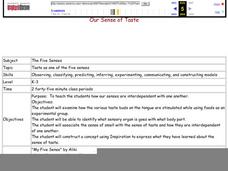Curated OER
Children's Literature Meets Learning Theories
Students examine learning theories and principles through children's literature. In groups, they select theories and create multimedia presentations exemplifying them. Students discuss the various themes related to human growth,...
Curated OER
Designing A Mythical Creature
Students study mythology and why human cultures require them. In this investigating myths instructional activity students design a creature that fits an explanation of a natural phenomena then demonstrate the concept of "myth" and...
Curated OER
The Nervous System and the Effects of Drugs
In this senses instructional activity, students use webbed information to answer several questions. Students read about each one of the five human senses in order to demonstrate an understanding of the material.
Curated OER
Be Considerate of Others
Students explore the environment by participating in an outdoors activity. In this nature appreciation lesson, students discuss how to minimize their human imprint when experiencing nature. Students conduct a nature walk and plan out an...
Curated OER
Be a Geography Observor and Recorder
Students investigate the human and physical features of their school neighborhood. They observe the physical and man made features outside, make illustrations of their observations, and develop a class list of their observations.
Curated OER
What's the Connection Between Convection and Inversion?
Ninth graders observe a simulation demonstrating the difference between convection and inversion. They explain where and when convection and inversion layers occur and how each impacts air quality, and by connection, human health.
Curated OER
Cave Paintings
Students examine various types of prehistoric art. In groups, they research the purpose of the drawings and use the internet to research the various ancient human groups. To end the lesson, they draw animals compared to the prehistoric...
Curated OER
Making Babies
Sixth graders complete a human traits survey. In this genetics lesson students read articles and fill out a worksheet on genotype and phenotypes.
Curated OER
Body Parts Vocabulary
Students identify the main parts of the human body. In this human body vocabulary lesson, students trace each other's body outline on butcher paper and label the parts of the body. Students define what each body part does. This lesson is...
Curated OER
How Does a Pedigree Help Us to Trace a Trait That is Inherited?
Students analyze genetic patterns. In this pedigree instructional activity, students determine dominant or recessive inheritance. They construct a human pedigree from genetic information.
Curated OER
Introduction to Biology
Students participate in a variety of activities to introduce them to biology. In this biology lesson plan, students use microscopes, discover bacteria, view human anatomy, and more.
Curated OER
Reading and Writing the Autobiography With a Study of Zora Neale Hurston
Students explore the possible relationships between characters in a novel. They read the novel 'Their Eyes Were Watching God' and answer all the questions on each chapter so that the characters and events are familiar to the students.
Curated OER
Our Sense of Taste
Students explore the relationship between the senses of taste and smell using a blindfold taste test. In partners, they taste different foods with their noses plugged and unplugged. They create a life size outline of the human body to...
Curated OER
Birth, Growing, and Aging
For this human development worksheet, students will review the three stages of birth and how your growth rate changes from childhood through adolescence to adulthood. This worksheet has 3 short answer questions, 4 fill in the blank, and...
Curated OER
Soybean Science
Fourth graders explore food science by participating in a cooking activity. In this soybean oil lesson, 4th graders listen as the teacher gives them a background on soybeans and their use by humans today. Students grind soybeans and...
ESL Kid Stuff
Measuring Parts of the Body
"How tall are you?" "Who has the longest arms?" As part of a study of the names of various body parts, language learners use rulers and tapes to measure parts of the body.
Curated OER
TE Lesson: Can You Taste It?
Students investigate how animals adapt to use its senses to identify foods that are nutritious or noxious. They determine how they associate foods with other things such as birthdays. They discuss the role of the nervous system in the...
Curated OER
Metaphor: Parts of the Body
For this metaphor--parts of the body worksheet, learners participate in describing parts of the body by utilizing metaphor phrases for a stronger description of key terms.
Curated OER
Martin Luther King, Jr.
In this online interactive history worksheet, students respond to 10 short answer and essay questions about the accomplishments of Martin Luther King, Jr. Students may check some of their answers on the interactive worksheet.
Curated OER
Butterfly Life Cycle
Focused little scientists will flitter their arms back and forth across the room with excitement as they learn the life cycle of a butterfly and how living things grow and change over time.
Curated OER
His or Her
In this his or her worksheet, students label body parts and clothes, write details about boys and girls, choose the correct words for sentences, and more. Students complete 4 activities total.
Curated OER
Body Parts Trace and Read
In this ESL body parts worksheet, students enhance their vocabularies by first tracing, then printing, and finally writing the body part vocabulary words on the lines.
Curated OER
Hand Sensitivity
Learners experiment with the sense of touch. In this tactile lesson, students determine the most sensitive area of the hand. Learners experiment by describing objects through touch only. Students compare the amount of sensory data...
Curated OER
ESOL Vocabulary for Body Parts
Students review and write the vocabulary for basic body parts. They identify parts of the body along with new verbs then complete an activity sheet of labeling body parts and complete sentences using the correct vocabulary word.























